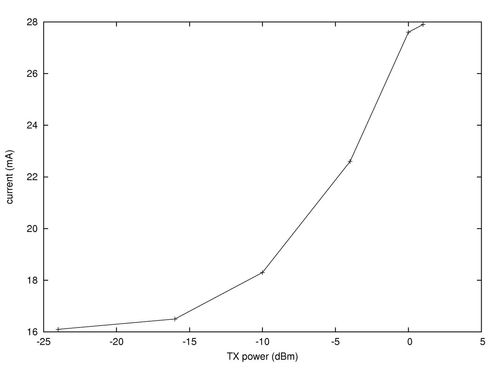...
In IEEE802.15.4 radios, the modulator burns more power than the power amplifier. The result is that a 10x reduction in the output power of the radio is rarely coupled to a corresponding reduction in radio current. Although those radios have some type of transmit power control, often over two orders of magnitude or more, the difference in radio current is rarely greater than 2x.
As an example, take the measurements presented above, obtained from an eZ430-RF2500 board equipped with a CC2500 radio. Note how a roughly 300x drop in transmit power (from 1dBm=1.25mW to -24dBm=0.004mW) translates in only a 42% decrease of the radio's current consumption (from 27.9mA to 16.1mA).
Before the first bit can be sent or received on the radio, a long sequence of events must typically take place inside the radio. From a deep sleep state, this entrails turning on a voltage regulator, waiting for a crystal oscillator to stabilize, and waiting for the radio oscillator to settle (tune) to the proper frequency, among other things. The figure above shows how a CC2500 radio takes roughly 1ms to switch between OFF and RX modes. The annotated phases are radio startup (A), radio frequency calibration (B), reception mode (C) and entering sleep (D).
...
The Beacon-Enabled mode follows a superframe structure, where a network coordinator transmits beacons at predetermined intervals. As shown below, following this beacons comes a Contention Access Period (CAP) where neighbors of the coordinator can talk to it following a slotted Aloha medium access scheme. During that period nodes can request a dedicated time slot in the Guaranteed Time Slot (GTS) period following the CAP.
IEEE802.15.4-2006 defines two device classes. The Full Function Device (FFD) is capable of participating in any topology, when it can play the role of network coordinator; it is capable of talking to any other device. The Reduced Function Device (RFD) can only participate in a star topology, can only talk to a network coordinator, and cannot become a network coordinator. While the idea is for a RFD to require less hardware resource, in practice all IEEE802.15.4-2006 devices are FFDs.
...



